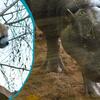Continuing our Creatures Unseen blogs, Sophie Sharman Frost from Moulton College, on their nocturnal inhabitants and how they support education...
For over 15 years I have been able to work with a selection of nocturnal mammals, this has included rats, sugar gliders, chinchillas and an Asian Palm Civet but this last couple of years have given me so much joy as a keeper where we introduced the Northern Luzon Giant Cloud rat to the collection, within a college setting. Being an unusual rodent, we were keen to house this fascinating species which are rarely seen in UK collections and are happy to share our knowledge with our student body.
In 2021 we collected our first Northern Luzon Giant cloud rat named Haggis and closely followed by a second called Thistle. Although I had encountered and worked with some large rodents before, I can only describe the pair as huge, fluffy, cute, chewers, who greeted us with a growl.
This species is endemic to the island of Luzon in the Philippines, where they spend most of their time in the canopy. Here we provide them with two large enclosures within our nocturnal centre, this is where the light cycle is switched in reverse. With this adaptation to their light cycle, we have been able to see and monitor behaviours whilst they are awake and more active.
Being around 2.5kg in weight we give them multiple fixed branches for them to explore, moving on all fours and even using their strong limbs and hands to hold branches upside down or hanging down to reach browse and other tasty treats. They receive a mixed diet of browse, leafy greens and a specialist diet called leaf eater. Spending most of their time up high in the trees we provide them with browse, they particularly love Bamboo and Hornbeam. They will spend time chewing the small stems and eating their leaves.
During December of 2022 we began to see mating from the pair and have since had one young born at the centre at the start of the Summer. During this time the Female spent a considerable amount of time collecting leafy browse and taking it into the nest box leading up to the baby’s arrival.
After a gestation of approx. 65 days, one youngster was born and we found mum and baby in the nest box, baby feeding and Haggis cleaning them.
As a small family group, they come together during feed time and move from each area to rest, groom, explore and socialise with each other. With little grunts and growls they communicated to each other, and Thistle gives us a growl in the morning to greet us, eagerly waiting for breakfast.
Being a strict hands-off animal, our students learn how to work closely with this species at a suitable distance. Students are able to service our animals throughout the day where they change waters, feed using different suitable enrichment devices within the canopy area to replicate natural foraging behaviours and skip waste products from around the enclosure. Learning how to identify suitable browse, learning about their origin, natural habitat and behaviours and how we can replicate and enhance that within a captive environment.
We use different training aids and methods to allow the animals to move around the enclosure freely which then allows us to ensure we are able to maintain regular weigh ins, to ensure the group are in tip top condition, here we use a hatch to separate the individuals from us where they walk to scales and we present a small treat item for their successful weigh in.
We are now eagerly waiting to be able to sex our youngster with our exotic’s vet so we can give them an official name!
- Sophie Sharman Frost, Animal Keeper - Industry Skills Supervisor at Moulton College
All blogs reflect the views of their author and are not a reflection of BIAZA's positions.
-
News
 Belfast Zoo helps to bring Christmas joy to Children’s Hospital 19th December, 2025Belfast Zoo joined the Lord Mayor of Belfast, Councillor Tracy Kelly, on Monday (15th December) to help bring festive cheer to the Royal Belfast Hospital…
Belfast Zoo helps to bring Christmas joy to Children’s Hospital 19th December, 2025Belfast Zoo joined the Lord Mayor of Belfast, Councillor Tracy Kelly, on Monday (15th December) to help bring festive cheer to the Royal Belfast Hospital… -
News
 Colchester Zoological Society welcomes new arrivals 19th December, 2025This December, Colchester Zoological Society (CZS) welcomed some exciting new arrivals! A young male pygmy hippo, Mikolas, from Zoo Dvur Kralove…
Colchester Zoological Society welcomes new arrivals 19th December, 2025This December, Colchester Zoological Society (CZS) welcomed some exciting new arrivals! A young male pygmy hippo, Mikolas, from Zoo Dvur Kralove… -
News
.png?w=100&h=100&zc=1&f=jpeg&hash=8d175f93cde920c5ba23c8ea7f92e55a) Blog: Understanding the human side of zoos 16th December, 2025Why are zoo researchers increasingly looking to social science? Dr Nieky van Veggel explains the significance of understanding the human dimension…
Blog: Understanding the human side of zoos 16th December, 2025Why are zoo researchers increasingly looking to social science? Dr Nieky van Veggel explains the significance of understanding the human dimension…



